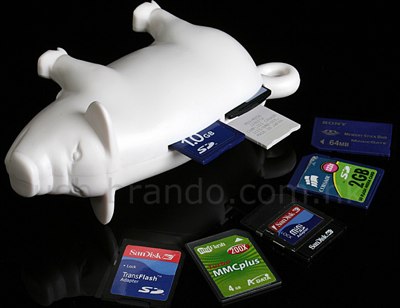
Card reader
A memory card reader is a device used for communication with a smart card or a flash memory card. A business card reader is a scanning device used to scan and electronically save business cards. A magnetic card reader is a device used to scan cards containing magnetic data strips. A punched card reader is a device used to read holes in punched cardboard cards.
Smart card readers
Some have a flash upgradeable firmware. The card reader supplies the integrated circuit on the smart card with electricity. Communication is done via protocols and you can read and write to a fixed address on the card.
| Name | Description |
|---|---|
| T=0 | Asynchronous half-duplex byte-level transmission protocol. |
| T=1 | Asynchronous half-duplex block-level transmission protocol. |
| T=2 | Reserved for future full-duplex operations. |
| T=3 | Reserved for future full-duplex operations. |
| T=CL | APDU transmission via contactless interface ISO 14443. |
If the card is not using any standard transmission protocol, but uses a custom/proprietary protocol it has the communication protocol designation T=14.
With latest PC/SC CCID specifications the PC/SC Workgroup (www.pcscworkgroup.com) has defined a new way of smart card framework. It works with USB devices with the specific device class 0x0B. Readers with this class doesn't need device drivers because the operating system manufacturer supplies it by default.
PKCS#11 is an API, designed to be platform independent, defining a generic interface to cryptographic tokens, such as smart cards.
Memory card readers
A memory card reader is a device, typically having a USB interface, for accessing the data on a memory card such as a CompactFlash (CF), Secure Digital (SD) or MultiMediaCard (MMC). Most card readers also offer write capability, and together with the card, this can function as a pen drive.
Some printers and personal computers have a built-in card reader.
Today card readers can be categorized into three by the type and quantity of the card slots: single card reader (e.g. 1x SD-only), multi card reader (e.g. 9-in-1) and series card reader (e.g. 4x SD only). However, there are some kinds of memory cards with USB functions that do not need the card reader, such as the Intelligent Stick memory card, which can plug directly into a USB slot.
A multi card reader is a device used for communication with more than one type of flash memory card. Multi card readers do not have any built-in memory capacity, but are able to accept multiple types and styles of memory cards. Multi card readers typically use a USB interface to connect with a USB-capable computer or other device, enabling users to access information stored in the memory card. The number of compatible memory cards varies from reader to reader and can include more than 20 different types. The number of different memory cards that a multi card reader can accept is expressed as x-in-1, with x being the number of memory cards accepted. Such as 35-in-1. There are three categories of card readers sorted by the type and quantity of the card slots: single card reader (e.g. 1x SD-only), multi card reader (e.g. 9-in-1) and series card reader (e.g. 4x SD only).
The USB device class used is 0x08.


No comments:
Post a Comment